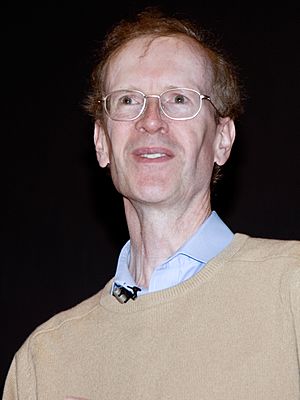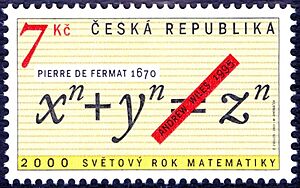Andrew Wiles facts for kids
Quick facts for kids
Sir Andrew Wiles
|
|
|---|---|

Wiles in 2005
|
|
| Born |
Andrew John Wiles
11 April 1953 Cambridge, England
|
| Education | Merton College, Oxford (BA) Clare College, Cambridge (MA, PhD) |
| Known for | Proving the Taniyama–Shimura conjecture for semistable elliptic curves, thereby proving Fermat's Last Theorem Proving the main conjecture of Iwasawa theory |
| Awards |
|
| Scientific career | |
| Fields | Mathematics |
| Institutions | |
| Thesis | Reciprocity Laws and the Conjecture of Birch and Swinnerton-Dyer (1979) |
| Doctoral advisor | John Coates |
| Doctoral students |
|
Sir Andrew John Wiles (born 11 April 1953) is a famous English mathematician. He is a professor at the University of Oxford and studies number theory. He is most famous for solving a very old math problem called Fermat's Last Theorem.
For his amazing work, he received the Abel Prize in 2016 and the Copley Medal in 2017. He was also made a Knight Commander of the Order of the British Empire in 2000. In 2018, he became the first Regius Professor of Mathematics at Oxford.
Wiles was born in Cambridge, England. His father was a theologian named Maurice Frank Wiles. Andrew became interested in math and Fermat's Last Theorem when he was a child, especially while living in Nigeria. After studying at Oxford, he worked on connecting different math ideas.
In the early 1980s, Wiles taught at the University of Cambridge and then at Princeton University. In 1986, he learned about new work that linked Fermat's Last Theorem to another math idea. This made him decide to try and prove the theorem himself. He worked on it secretly for many years.
By 1993, he thought he had found the proof. However, a small mistake was found later. After a new idea came to him in September 1994, Wiles and his student Richard Taylor fixed the problem. They published their proof in 1995, and it was celebrated by mathematicians everywhere.
By proving Fermat's Last Theorem, Wiles created new ways for mathematicians to solve other problems. His work helped other mathematicians prove the full modularity theorem by 2000. Wiles believes his work didn't just solve one problem, but helped push the whole field of mathematics forward.
Contents
Becoming a Mathematician
Early Life and School Days
Andrew Wiles was born on April 11, 1953, in Cambridge, England. His father, Maurice Frank Wiles, was a chaplain and later a professor.
As a very young boy, Andrew lived with his parents in Nigeria. At first, he didn't want to go to school. But he later said he couldn't remember a time when he didn't enjoy solving math problems.
He went to schools in Cambridge, including King's College School, Cambridge and The Leys School, Cambridge.
Discovering Fermat's Last Theorem
When Andrew was 10 years old, he found a book called The Last Problem at his local library. This book was about Fermat's Last Theorem. He was amazed that such a simple-sounding problem had never been solved.
He decided he wanted to be the first to prove it. But he soon realized he didn't know enough math yet. He put his childhood dream aside for a while.
His interest in the theorem came back when he was 33. This happened after new math discoveries linked the theorem to other ideas.
University Studies
In 1974, Wiles earned his first degree in mathematics from Merton College, Oxford. He then started his advanced research in 1975. He worked on complex math problems with his advisor, John Coates.
In 1980, Wiles earned his PhD from Clare College, Cambridge. After spending some time in Princeton, New Jersey, he became a professor at Princeton University in 1981.
Solving Fermat's Last Theorem
The Big Challenge
From 1988 to 1990, Wiles was a professor at the University of Oxford. Then he returned to Princeton. From 1994 to 2009, he was a special professor there.
In 1986, mathematicians realized that Fermat's Last Theorem could be proven. This theorem states that no three positive whole numbers a, b, and c can solve the equation an + bn = cn if n is a whole number greater than 2.
The key was to link it to something called the "modularity theorem." This theorem was about special math objects called elliptic curves. If Fermat's Last Theorem was false, it would create a very strange curve. Proving the modularity theorem would show such a curve couldn't exist.
Many mathematicians thought this problem was too hard to solve. But Wiles, who had been fascinated by Fermat's Last Theorem since childhood, decided to try.
Years of Secret Work
Wiles spent over six years working on this problem in secret. He didn't tell many people what he was doing. He only shared his progress with his wife. He published older work in small parts to keep his main project hidden.
His plan was to use a "proof by contradiction." He would assume Fermat's Last Theorem was false. Then, he would show that this assumption led to a contradiction with other known math rules.
He found that the modularity theorem applied to the specific type of elliptic curves linked to Fermat's equation. This meant that if the modularity theorem was true for these curves, then Fermat's Last Theorem had to be true.
The Proof and the Flaw
In June 1993, Wiles finally presented his proof at a conference. He talked about complex math ideas, and at the very end, he quietly announced that he had proven Fermat's Last Theorem. Everyone was amazed!
However, in August 1993, a small mistake was found in his proof. Wiles tried for over a year to fix it. He was almost ready to give up.
The Breakthrough
Then, on September 19, 1994, Wiles had a new idea. This idea helped him get around the mistake. He worked with his former student, Richard Taylor, to complete the proof.
They published two papers in May 1995. These papers showed the full, correct proof of Fermat's Last Theorem.
Later Achievements
In 2011, Wiles returned to the University of Oxford as a Royal Society Research Professor. In May 2018, he was named the first Regius Professor of Mathematics at Oxford.
Wiles's Impact on Math
Wiles's work has been very important for many areas of mathematics. In 1999, some of his former students, including Richard Taylor, used his proof to show the full modularity theorem.
Many of Wiles's students have also become very successful mathematicians. This includes Manjul Bhargava, who won the Fields Medal in 2014.
When he received the Abel Prize in 2016, Wiles said that his methods didn't just solve Fermat's Last Theorem. They also opened up new ways to tackle other big math problems, like the Langlands program. This program tries to connect different parts of mathematics.
Awards and Honors
Wiles's proof of Fermat's Last Theorem has been carefully checked by other math experts and found to be correct. His story was even featured in a BBC documentary called Horizon and a book by Simon Singh called Fermat's Last Theorem.
Wiles has received many important awards for his work:
- He won the Whitehead Prize in 1988.
- He became a Fellow of the Royal Society in 1989.
- In 1995, after completing his proof, he received the Schock Prize, Fermat Prize, and Wolf Prize in Mathematics.
- In 1996, he won the Royal Medal and the NAS Award in Mathematics.
- In 1997, he received the Cole Prize, a MacArthur Fellowship, and the Wolfskehl Prize.
- In 1998, he was given a special silver plaque from the International Mathematical Union. This was because he was too old for the Fields Medal, which is for mathematicians under 40.
- The asteroid 9999 Wiles was named after him in 1999.
- In 2000, he was made a Knight Commander of the Order of the British Empire.
- He won the Shaw Prize in 2005.
- In 2013, the math building at the University of Oxford was named after him.
- He won the prestigious Abel Prize in 2016.
- In 2017, he received the Copley Medal.
- He won the De Morgan Medal in 2019.
Images for kids
-
Andrew Wiles in front of a statue of Pierre de Fermat in 1995.
See also
 In Spanish: Andrew Wiles para niños
In Spanish: Andrew Wiles para niños



